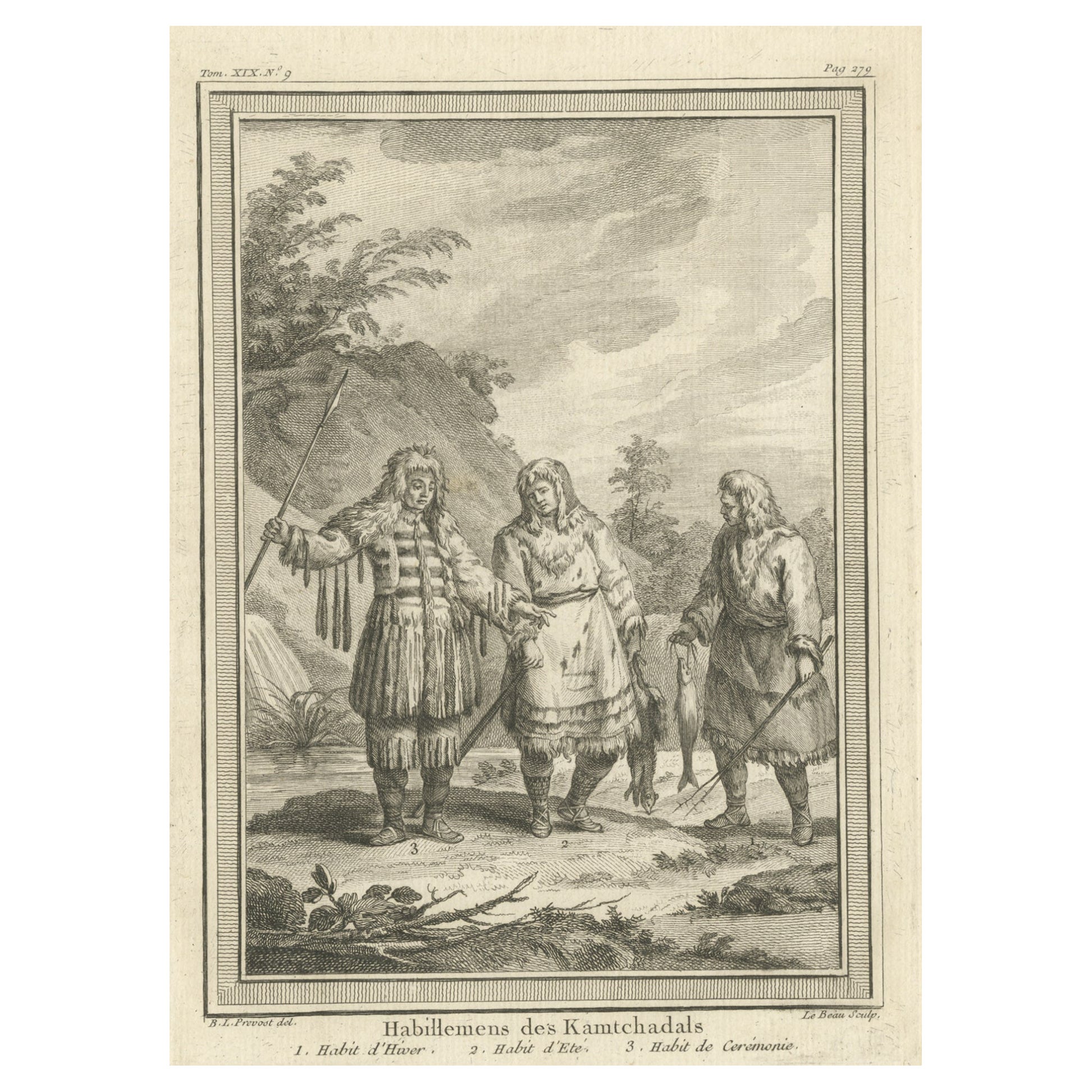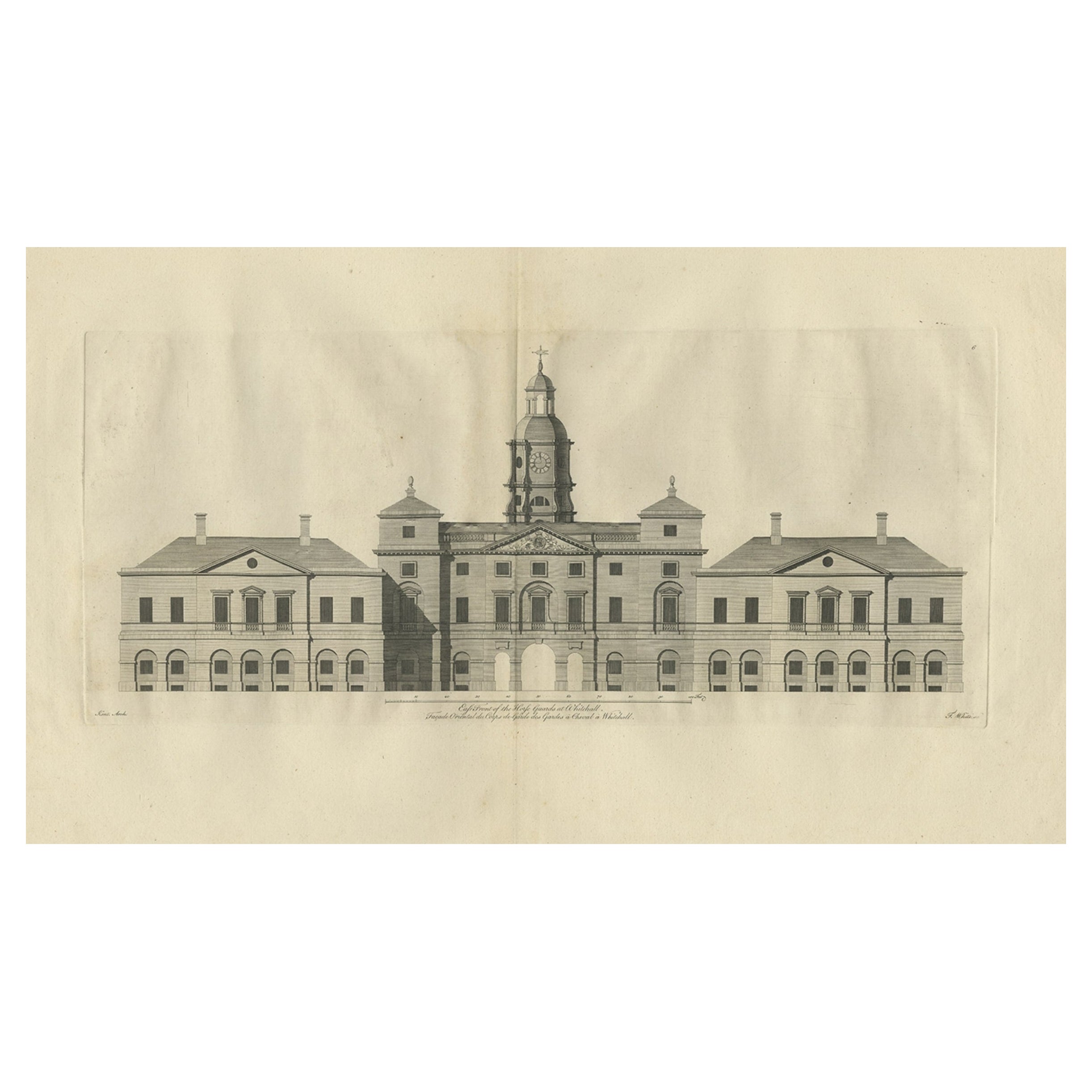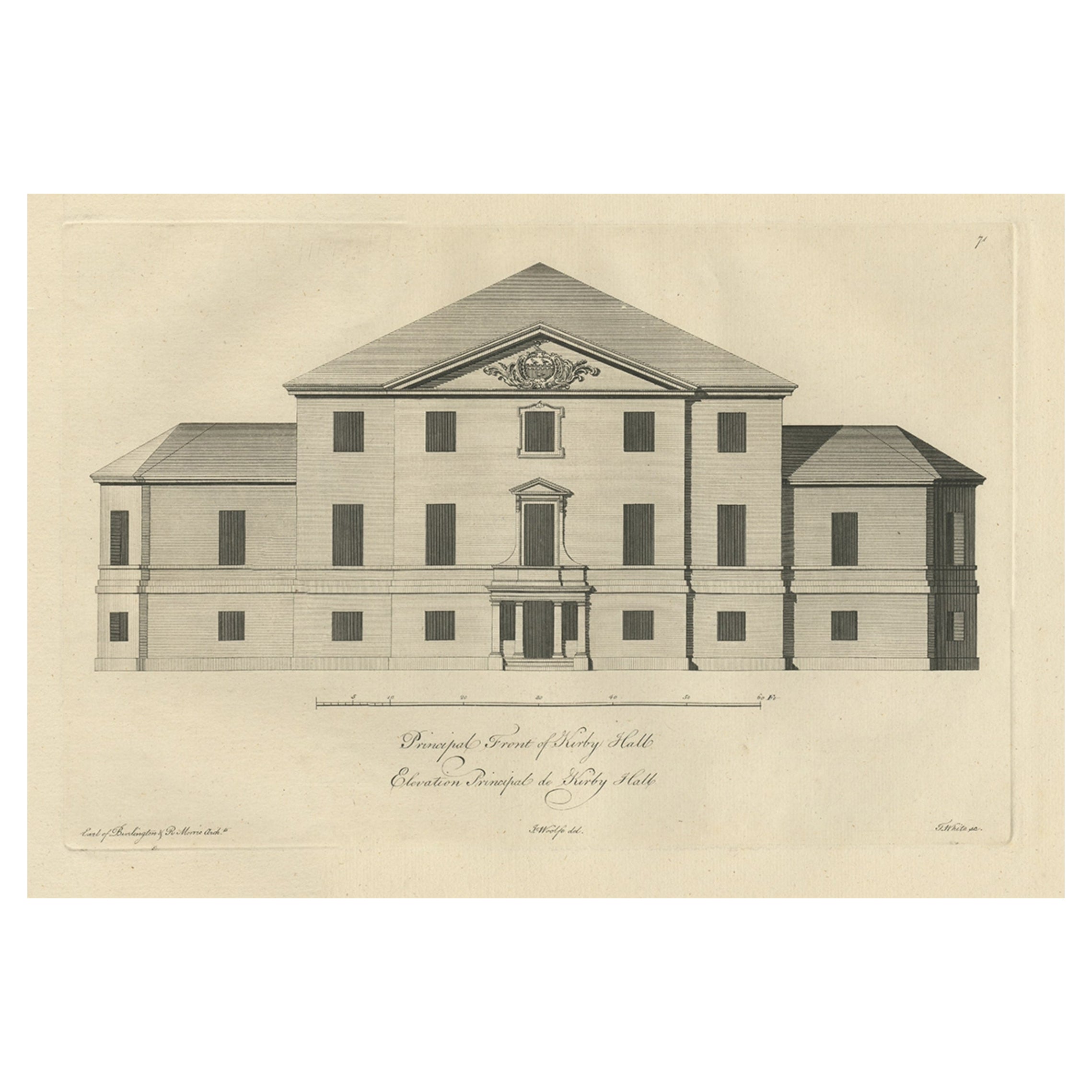Items Similar to Sarah Porter, "Queen of the Touters at Tunbridge Wells" Engraving, circa 1770
Want more images or videos?
Request additional images or videos from the seller
1 of 14
Sarah Porter, "Queen of the Touters at Tunbridge Wells" Engraving, circa 1770
About the Item
After Vander Smissen 'Mrs Sarah Porter, Queen of the Touters at Tunbridge Wells', a mezzotint, engraved by William Pether circa 1770, glazed in ebonised, gilt & gesso wood frame.
Age related browning to the engraving, losses to the gesso work.
A residence of Tunbridge Richard ‘Beau’ Nash declared himself Master of Ceremonies in 1735, and set to make TW a place to visit so invited Dippers, musicians, bellringers, waiters, clergy, booksellers to the town and they all had to be paid and Nash set subscriptions to be levied from visitors.
He employed Sarah Porter, who became known as the ‘Queen of the Touters’, for this task. She would stand at the door of the ballroom and greet each new arrival, enquiring after their mother, sister, brother or aunt, as though she was intimately acquainted with them. The visitor would then be expected to pay up. If they refused, Sarah would follow them round the room, with paper and pencil in hand, until they did so. However annoyed people became, however rude they were to her, she never lost her cool or became uncivil.
The same engraving is housed within the collections of the British Museum, The National Portrait Gallery and The Royal Collection
A hand written explanation on the reverse dated, 1832 penned by a Tunbridge Wells Resident Mrs Buttons???
Measures: 37 / 45 / 3cm.
- Dimensions:Height: 17.72 in (45 cm)Width: 14.57 in (37 cm)Depth: 1.19 in (3 cm)
- Materials and Techniques:
- Place of Origin:
- Period:
- Date of Manufacture:1770
- Condition:Wear consistent with age and use. Minor losses.
- Seller Location:Lowestoft, GB
- Reference Number:1stDibs: LU4612133174032
About the Seller
5.0
Platinum Seller
These expertly vetted sellers are 1stDibs' most experienced sellers and are rated highest by our customers.
Established in 2013
1stDibs seller since 2019
Typical response time: 1 hour
- ShippingRetrieving quote...Ships From: Lowestoft, United Kingdom
- Return PolicyA return for this item may be initiated within 7 days of delivery.
More From This SellerView All
- 'In Memory of Jacko" the Champion Ratter circa 1850 Taxidermy Dog InterestLocated in Lowestoft, GBA rather curios Victorian diorama of "Jacko" the ratter c.1850, a plaster model of a terrier presented in a period glass dome mounted with its original ebonised stand. Jacko is mounted on a purple velvet cushion with gold threaded decoration. Mounted between his feet is a circular silver medal, the obverse inscribed 'In memory of Jacko, the Champion Terrier 14 lb Weight', the reserve inscribed 'Presentation Medal to Canine Fancier and M.P.R. Jemmy Shaw London 1852', The diorama came from the collection of Jack Webb (1923-2019), London. Jemmy Elton Shaw, also known as Jimm and James was a 19th century pioneer fancier of the early dog show days, a promoter of dog fighting and rat-baiting contests, a breeder of Old English bulldogs, bull terriers and toy terriers...Category
Antique Mid-19th Century English Early Victorian Taxidermy
MaterialsGlass, Plaster, Pine
- The Rules & Order of Cockfighting On Parchment With Seal Dated 1757 CurioLocated in Lowestoft, GBA wonderful display of late 18th, early 19th century cock fighting paraphernalia with silver spurs, feathers and a cockfighting hood. Along with the paraphernalia there is also a ma...Category
Antique 18th Century English Historical Memorabilia
MaterialsSteel
- Satirical Lithograph by Peter Jacques "the Devil" London Artist Royal AcademyBy Peter JacquesLocated in Lowestoft, GBA fine ink and hand tinted etching by Peter Jacques Little is known about Peter, he was a printmaker, working in etching and watercolour, who studied ...Category
Vintage 1970s English Contemporary Art
MaterialsPaper
- William Theed the Younger 1804-91 Marble Bust of William Ewart Gladstone 1868Located in Lowestoft, GBA very finely carved marble bust of William Ewart Gladstone dated 1868 and signed W.Theed SC William Theed was born in Staffordshire, his father, William Theed the elder being a sculptor and a craftsman at Wedgwood, known for his major work, Hercules and the Thracian Horses for one frontage of the Buckingham Palace complex. The younger Theed studied at the Royal Academy Schools, then worked for the sculptor E. H. Baily. Five years on, in 1826, he went to Rome, where he was to stay a total of 22 years, during that time working in the studios of Thorwaldson and John Gibson. Returning to London in 1848, Theed enjoyed a good reputation, being a favoured sculptor of Queen Victoria, and was commissioned to produce many portrait statues, busts, and large monuments. He showed work in the 1851 Great Exhibition, and among other high points were a group for the Albert Memorial, and five standing figures on the Inland Revenue side of Somerset House, representing Manchester, Edinburgh, Glasgow, Belfast and Dublin. Theed's statues may be seen in St Paul's (Henry Hallam), Manchester (Monument to Chetham in the Cathedral, Gladstone and Thomas Bright for the Town Hall, and James Watt in Piccadilly Gardens), Huddersfield (Robert Peel), Winchester (David Williams monument in the Cathedral), and Prince Albert statues for Grimsby, and in Australia in Macquairie Street, Sydney. He was also responsible for three of the portrait statues (Bacon, Locke, Adam Smith...Category
Antique 1860s English Victorian Busts
MaterialsMarble
- 19th Century Circa 1860 Victorian Miniature English White Terrier TaxidermyLocated in Lowestoft, GBA very rare Victorian taxidermy dog, often scaled down by the best naturalist of the period. Also could be the extinct English White Terrier circa 1860 ...Category
Antique Mid-19th Century English Victorian Taxidermy
MaterialsNatural Fiber, Glass, Pine
- 20th C Anthropomorphic Taxidermy Drinking Toads Curio Manner of Walter PotteLocated in Lowestoft, GBA pair of drinking toads, housed a pine glazed case, with a collage back drop. Very much in the manner of Walter Potter, mid 20th century in age. Measures: 23.5cm in width 11...Category
Mid-20th Century British Taxidermy
MaterialsNatural Fiber, Pine
You May Also Like
- Antique Religious Print 'No. 13' Rebecca and Eliezer at the Well, circa 1840Located in Langweer, NLAntique print titled ‘Histoire Sainte, Ancien Testament, Éliezer et Rebecca.’ This plate shows a scene from the Old Testament; Rebecca and Elizer at the Well.’ This print originat...Category
Antique Mid-19th Century Prints
MaterialsPaper
- Antique Print of the South-East Facade of the Mansion at Kirtlington Park, c1770Located in Langweer, NLAntique print titled 'South East Front of Kirtlington Park (..)'. View of the south-east facade of the mansion at Kirtlington Park, Oxfordshire. This print originates from 'Vitru...Category
Antique 18th Century Prints
MaterialsPaper
- Copper Engraving of Kamchadal Women from Kamchatka, Russia, 1770Located in Langweer, NLDescription: Antique print titled 'Habillemens des Femmes du Kamtchatka'. Copper engraving of Kamchadal women. This print originates from volume 19 of 'Histoire generale des voyages (..)' by Antoine Francois Prevost d'Exile. Artists and Engravers: Published by Panckoucke. The Kamchadals inhabit Kamchatka, Russia. The name "Kamchadal" was applied to the descendants of the local Siberians and aboriginal peoples (the Itelmens, Ainu, Koryaks and Chuvans) who assimilated with the Russians. The descendants of the mixed-blood Russian settlers in 18th-19th century are called Kamchadals these days. The Kamchadals speak Russian with a touch of local dialects of the aboriginal languages of Kamchatka. The Kamchadals engage in fur trading...Category
Antique 1770s Prints
MaterialsPaper
- Copper Engraving of Kamchadal Men from Kamchatka, Russia, 1770Located in Langweer, NLDescription: Antique print titled 'Habillemens des Kamtchadals'. Copper engraving of Kamchadal men. This print originates from volume 19 of 'Histoire generale des voyages (..)' by Antoine Francois Prevost d'Exile. Artists and Engravers: Published by Panckoucke. The Kamchadals inhabit Kamchatka, Russia. The name "Kamchadal" was applied to the descendants of the local Siberians and aboriginal peoples (the Itelmens, Ainu, Koryaks and Chuvans) who assimilated with the Russians. The descendants of the mixed-blood Russian settlers in 18th-19th century are called Kamchadals these days. The Kamchadals speak Russian with a touch of local dialects of the aboriginal languages of Kamchatka. The Kamchadals engage in fur trading...Category
Antique 1770s Prints
MaterialsPaper
- Antique Print of the Horse Guards at Whitehall, Westminster, London, ca.1770Located in Langweer, NLDescription: Antique print titled 'East Front of the Horse Guards at Whitehall'. Architectural elevation of the Horse Guards at Whitehall....Category
Antique 1770s Prints
MaterialsPaper
- Antique Engraving of Kirby Hall Near Gretton, Northamptonshire, England c.1770Located in Langweer, NLAntique print titled 'Principal Front of Kirby Hall'. Kirby Hall is an Elizabethan country house, located near Gretton, Northamptonshire, England. The nearest main town is Corby. One of the great Elizabethan houses of England, Kirby Hall was built for Sir Humphrey Stafford of Blatherwick, beginning in 1570. In 1575 the property was purchased by Sir Christopher Hatton of Holdenby,[1] Lord Chancellor to Queen Elizabeth I. It is a leading and early example of the Elizabethan prodigy house. Construction on the building began in 1570, based on the designs in French architectural pattern books and expanded in the Classical style over the course of the following decades. The house is now in a semi-ruined state with many parts roof-less although the Great Hall and state rooms remain intact. The gardens, with their elaborate "cutwork" design, complete with statues and urns, have been recently restored. Anne of Denmark stayed at Kirby on 9 August 1605 while King James stayed at Rockingham Castle. King James stayed for three days in August 1616. During a royal progress Esmé Stewart, 3rd Duke of Lennox died at Kirby of the "spotted ague" on 30 July 1624. The building and gardens are owned by the Earl of Winchilsea and are managed by English Heritage. Kirby Hall has been used as a filming location in many productions. These include the following; an episode (6. Protest and Communication) of Kenneth Clark...Category
Antique 18th Century Prints
MaterialsPaper
Recently Viewed
View AllMore Ways To Browse
Ebonised Gilt
New England Doors
18th Century Pen
Engraved Glass Door
Framed 18th Century British Prints
Musician 18th Century
Antique Wood Buttons
Antique Ballroom
Levy House
Queen Pen
Tunbridge Wells
Antique Tunbridge Wells
Antique Furniture Tunbridge Wells
Antique Pen And Pencil Sets
Antique Pen And Pencil Set
Door Porter
Sarah Porter
Antique Dipper





